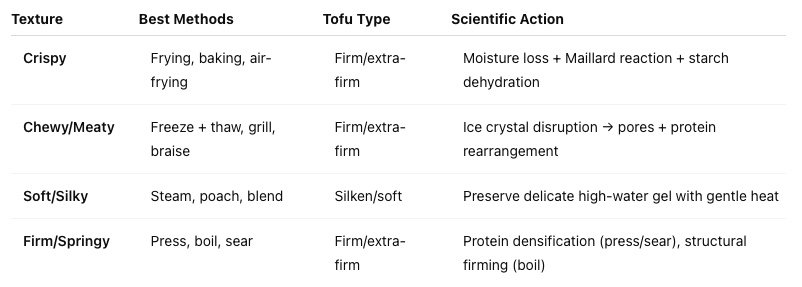The Science Behind Tofu Textures: Why Cooking Methods Matter
Why This Blog Exists
Tofu isn’t just a blank canvas — it’s a shape-shifter, a storyteller, and a quiet culinary revolution waiting to unfold. This blog is for every curious cook who’s ever wondered: Why does tofu sometimes turn out chewy, other times crispy, and sometimes just… mushy?
Whether you’re pan-frying for crunch, freezing for bite, or steaming for silken softness, each method rewrites the very structure of tofu. And that’s where science steps in — not to overcomplicate things, but to empower you with a deeper understanding.
Because when you know how tofu transforms, you unlock its full potential — and you get to choose the texture, not just take what comes.
🔥 Crispy Tofu – Golden, Crunchy, and Addictive
How to Achieve It
Use firm or extra-firm tofu
Press it well (15–30 mins minimum — longer = better)
Cut into cubes or slabs and pat dry thoroughly
Toss in starch (cornstarch, potato, or rice flour)
Fry, bake, or air-fry at high heat until golden and crisp
Why It Works
Water removal is crucial: less surface moisture = higher temps = better browning
The Maillard reaction kicks in above ~140°C, creating flavour and colour
Starch forms a brittle shell that crisps when dehydrated under heat
Pro Tip:
Let tofu sit for a few minutes after coating in starch — it hydrates slightly and helps the crust adhere better.
🧊 Chewy or Meaty Tofu – Dense, Absorbent, and Satisfying
How to Achieve It
Freeze a whole block of firm or extra-firm tofu
Thaw completely, then press again to remove water
Use in stir-fries, braises, or grilled dishes
Why It Works
Freezing forms ice crystals that physically tear open the tofu’s internal gel network
Thawing and pressing removes water, leaving the porous, sponge-like texture
As water exits, protein-protein interactions strengthen, creating chew
Pro Tip:
Whole-block freezing leads to larger ice crystals → bigger pores → spongier texture. Smaller pieces freeze faster but have a finer texture.
🥣 Soft & Silky Tofu – Gentle, Creamy, and Delicate
How to Achieve It
Use silken or soft tofu (no pressing!)
Steam, poach, or serve cold with minimal handling
Blend gently for sauces, smoothies, or dressings
Why It Works
Silken tofu is a delicate, continuous gel made without pressing
Gentle cooking preserves the fragile network and high moisture
Blending works beautifully because there’s no curd structure to break down
Pro Tip:
Silken tofu is set directly in its container — treat it like a custard, not a block.
💪 Firm & Springy Tofu – Structured, Bouncy, and Resilient
How to Achieve It
Use firm or extra-firm tofu
Press well to expel water
Optionally boil briefly (in water or broth)
Pan-sear for texture and contrast
Why It Works
Pressing densifies the protein matrix, reducing fragility
Boiling causes protein denaturation and tightening, improving resilience
Searing promotes Maillard browning and adds textural contrast
Myth Buster:
Searing doesn’t "seal in moisture" — it actually drives it out, creating better browning.
🧠 Quick Science Notes
Protein Denaturation: Unfolding and bonding of proteins under heat. In tofu, 7S globulin denatures ~71–76°C, 11S ~92–93°C — but higher surface dehydration = higher denaturation temp. Denaturation improves texture and often digestibility.
Freezing Effects: Ice crystals rupture tofu’s gel. Thawing drains water → sponge-like texture. New protein-protein bonds add chew.
Starch Crisping: Starch absorbs moisture, gelatinises, then dehydrates under heat, forming a crispy shell. No gluten = no chew, just crisp.
Water-Holding Capacity (WHC): A tofu’s ability to retain water. Lower WHC = firmer texture. Influenced by pressing, heating, coagulation pH, and coagulant type (e.g., calcium sulfate, magnesium chloride, GDL).
Maillard Reaction vs. Caramelisation:
Maillard: Protein + sugar → browning/flavour @ ~140–165°C
Caramelisation: Sugar-only browning >160°C
In practice, both may occur simultaneously during high-heat cooking
📊 Tofu Texture Summary Table
🛠️ Common Issues & Fixes
Too soft? → Try freezing + thawing, then pressing, or use extra-firm tofu
Won’t crisp? → Press longer, use a starch coating, and increase heat (but don’t crowd the pan)
Falls apart? → Use firmer tofu or boil briefly before stir-frying for extra resilience
Still bland? → Freeze-thaw for better absorption, then glaze after cooking for maximum flavour
🌱 Final Thoughts
Tofu isn’t one thing. It’s a spectrum — soft like silken pudding, crisp like a golden crust, chewy like a plant-based steak. And every texture tells a story.
Understanding the science behind these transformations doesn’t make cooking more complicated — it makes it more creative. It puts the power back in your hands. You choose the texture. You guide the outcome.
So next time you reach for a block of tofu, remember: you’re not just cooking. You’re shaping it. Transforming it. Mastering it.
Let’s tofu-fy the world, one texture at a time. ✨


